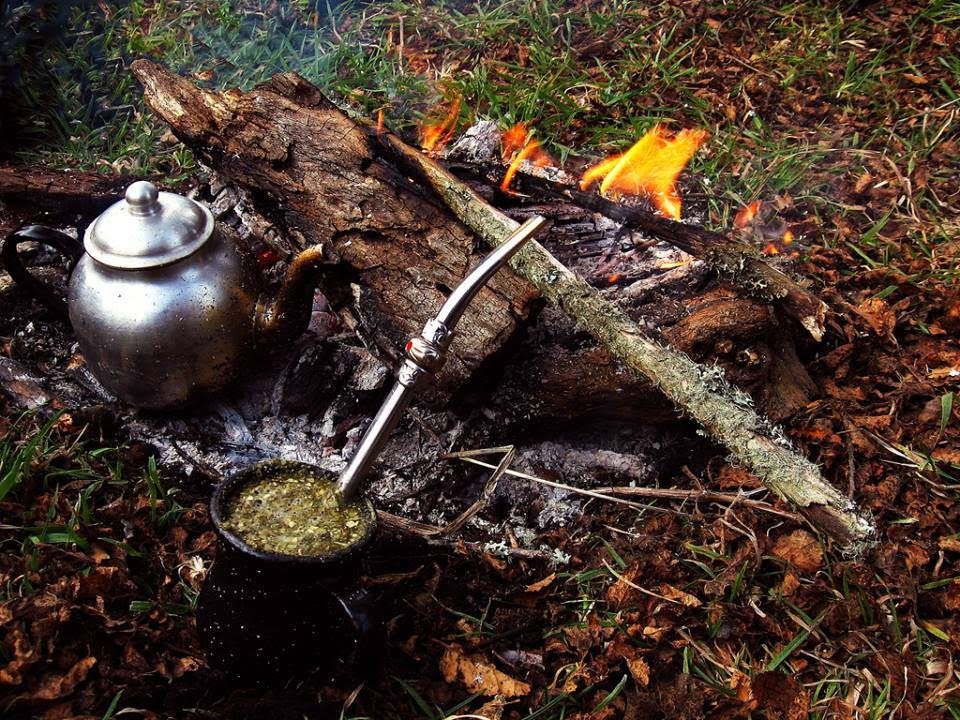Mate: The Social Ritual for Leadership and High Performance
This week we embark into the captivating world of Mate, part of the everyday culture in Argentina.
Today’s post is the product of a moment of inspiration while drinking Mate a few days ago, related to the ritual it represents more than to the drink itself. Let’s state something upfront: Mate is a bitter and somewhat tasteless tea-like infusion that you sip from a container (gourd) with a straw, not from a cup. It is an acquired taste and if I were to offer you one now, probably you won’t like it a lot. But again, it’s not about the taste (imagine a sort of green tea), but due to the way you pour water and sip, again and again for a long time, it’s more about the company it offers.
Mate is a ritual, provides company, requires patience.
Here you have my (real) Saturday morning mate…
“The treat” today is very special, rather than at the end, I share it here so you can enjoy the music that keeps me company while writing this Saturday morning… drinking mate
The Power of Rituals
As I sip from the straw (silver, not plastic) of my Mate this early Saturday morning, I reflect on the power of rituals. Like secret recipes, rituals had the strange ability to create a sense of purpose, foster unity and collaboration, and enhance performance. Rituals can have a profound impact on individuals and groups. Rituals provide structure, meaning, and a shared sense of identity within a team. Rituals create focus and provide clarity. What is even more important, rituals transform siloed teams into communities, moving expectations from the dangerous “me” to the powerful “we”.
Creating team rituals is a great way to build a strong “all-for-one” and “one-for-all” culture: “This is what We do together and this is what We do for each other.”
Rituals matter because rituals leverage teams trust!
Mate is a meticulously prepared drink that is meant to be shared.
It typically consists of just 2 ingredients, Yerba and hot water, but trust me, the way my sister prepares hers is always superior to mine. It’s that details matter, starting with the perfect temperature for the water. It has to be hot, but not boiling, not too hot, but not cold. Some people add half a teaspoon of sugar to take the acidic edge of the Yerba, and then they never add sugar again. Others like it sweet so they add sugar with every new pouring of water. Some add a dry peel of orange skin which adds a very subtle orangey taste. Let alone that not two Yerba brands taste exactly the same…
You can drink Mate by yourself, this is exactly what I am doing right now, but if you are with a group, unlike with tea or coffee, you won’t give a Mate gourd to each individual. You will prepare only one Mate for everybody, and only one person will be in charge of keep the round going.
Can you imagine that someone invites a group of friend to their house, offer them coffee and brings only one cup to share, one cup of coffee for everybody, so people can take turns at sipping from it? Impossible to imagine, right? Well, if I invite a group of friends to my house and I offer to drink Mate, I will only bring one Mate. I will lead by taking care of the mate, changing or adding Yerba (the herbs), keeping the water temperature stable, pouring water each time someone finishes drinking (sucking the straw) and keeping the round going. We will all share, and this is what makes drinking Mate with a group a unique experience, like a special connection. Not only you are not just drinking something in your own cup at your own pace; but you are creating a shared experience at a collective pace. This is why I believe that the drinking of Mate serves as a remarkable metaphor of the importance of creating leadership rituals.
“The difference between an event that feels like forced fun and a true ritual with meaning is some form of spiritual connection, the connection to a broader purpose.” - Bryan Hancock (McKinsey’s partner)
Mate as the Metaphor
In Argentina, mate is more than just a beverage; it is a cultural ritual deeply ingrained in daily life The process of preparing mate involves attention to detail, patience, and a commitment to craftsmanship. Similarly, leadership requires attention, preparation, patience, and dedication to developing oneself and others.
In the world of Mate, there is always that person that is known for “preparing the best mate”, who naturally gets appointed as leader of the round.
Sharing a round of Mate signifies a bond, it requires trust and it represents a commitment to patience and solidarity.
When people come together is when the magic happens, and drinking Mate makes people come together.
The fact that mate is by definition a drink to be shared further reinforces its metaphorical significance.
You can’t drink two mates in a row for example, when you finish sipping the water, you have to give it back to the leader who will will pour hot water again and give it to the next person, You have to wait until the round is complete for the Mate to come back to you again.
In leadership, building trust, fostering unity and collaboration among team members is essential for achieving high performance.
The Mate ritual revolves around a shared experience but led by one in the group.
Just like passing the Mate gourd around and sipping the beverage, a leader can encourage their team members to participate in rituals that promote a real sense of togetherness. Whether it's a daily stand-up meeting or a weekly brainstorming session, establishing consistent rituals allows team members to connect, communicate, and collaborate effectively. This sense of unity creates belonging, strengthens relationships, builds trust, and enhances team dynamics, laying the foundation for high performance. This act symbolizes the shared responsibility to collective outcomes and a common purpose that leaders must cultivate within their teams not only feel them feel they are part of something bigger than themselves, but also to create the high performance dynamic that allows the total output of the team be greater than the sum of the individual parts.
Beyond fostering unity, the Mate ritual emphasizes the importance of collaboration.
In Mate circles, everyone participates by taking turns and passing the gourd around. Mate is a great equalizer, everyone in Argentina drinks Mate, rich or poor, and everybody shares. This egalitarian practice teaches leaders that every team member's voice matters and should be heard. By incorporating collaborative rituals into your leadership approach, you help create an inclusive environment where diverse perspectives are valued. This not only sparks creativity and innovation but also ensures that each team member feels empowered and motivated to contribute their best, to show up at their best.
Lastly, the Mate ritual teaches leaders the value of productivity and focus.
In Argentina Mate is brought to the office and often shared during work breaks, providing a moment for bonding, sharing anecdotes or reflections. By encouraging rituals that allow team members to pause, recharge, and refocus, leaders can help combat burnout and improve productivity. Whether it's a daily mindfulness session or a weekly team outing, incorporating these rituals cultivates a culture of well-being and balance, ultimately leading to higher performance levels and greater overall success.
In conclusion, the Mate ritual serves as a powerful metaphor for a leader seeking to build high-performing teams. By embracing the principles of unity, collaboration, and productivity by focus, any manager and leader can create a work environment that rewards those who contribute to foster strong relationships, value diverse perspectives, and promote a healthy work-life balance.
I invite you to give it a try: raise your Mate gourd, sip from its wisdom, and watch your team's performance soars to new heights.
A few points I want to reinforce, but in the format of Q&A
Q1: Can rituals improve team performance? Absolutely! Rituals are not industry-specific and can be adapted to enhance team performance in any field. The key is to identify the unique needs and dynamics of your team and design rituals accordingly.
Q2: How can leaders overcome resistance to implementing rituals? Resistance to change is natural, but leaders can overcome it by clearly communicating the benefits of rituals, involving team members in the process of designing rituals, and demonstrating the positive impact through tangible results.
Q3: Are rituals effective in virtual or remote teams? Yes, rituals can be just as effective in virtual or remote teams. In fact, they are essential for creating a sense of connection and belonging. Virtual team-building activities, regular video meetings, and shared virtual rituals can foster unity and high performance.
Q4: Can rituals enhance employee satisfaction and engagement? Definitely. Rituals create a sense of belonging, purpose, and appreciation among team members. When employees feel connected and valued, their satisfaction and engagement levels increase, leading to higher productivity and performance.
Q5: How long does it take for rituals to become ingrained in a team's culture? The time it takes for rituals to become ingrained in a team's culture can vary. It depends on factors such as the team's receptiveness, consistency in practicing the rituals, and the level of support and reinforcement from leaders. it may take a few weeks to several months for rituals to become a natural part of the team's routine.
P.S. Before I go, here today a second “treat.” Enjoy as you bid farewell to this post
Lead yourself, Learn to live. Lead others, Learn to Build.
P.S. If you enjoyed reading this post consider subscribing to the newsletter, joining the community and sharing your thoughts.












Thank you for giving us such a great insight into the Argentinian tradition/ritual of mate. After you mentioned it previously I googled to educate myself and funny enough, few days later, a Spanish teacher I follow on Instagram posted a pic of her mate and was explaining to her students what it is. Reflecting on this ritual and its significance I realized that in my culture, although we don't have mate, we use coffee to welcome friends and relatives into our homes. Most of the time people already had enough coffee that particular day but would still drink it not because they need it but because as you mentioned, it creates a sense of togetherness which we all cherish. I also like how you explain that a ritual in a workplace creates better teams, foster creativity, exchange of ideas and most importantly give a sense of belonging. Thank you for a great piece of writing and sharing this important Argentinian ritual! Looking forward to the next one. Have a great week :)
Thank you for sharing this personal perspective, Sebastian. There’s truly a lot of wisdom in rituals.